by Mike Bendzela
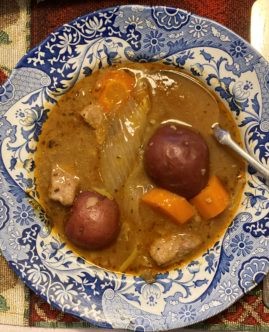
We never travel, mainly because working a farm is a career, even a small one like ours, and also because my spouse’s Type 1 diabetes is better managed in a sedentary, predictable existence. I realized in marriage that I would never become “worldly” and didn’t care. I would have to learn whatever I could about the world on this “postage stamp of soil” (1), in William Faulkner’s memorable phrase. This existence has certainly turned us into “foodies” (scare quotes indicating how much I detest the term), even bad-ass foodies in our case, foodies such as our grandparents were. No, strike that–our great grandparents. How many people can say they grow their own stew?
During my twenties and thirties, when we first embarked on this course of Do It Yourself food production, I aspired to be “Green,” “Sustainable,” and “Self-sufficient”–even “Organic”! These are lofty ideals that died directly during their attempted implementation. All these decades later, I’ve settled for home food production and preservation that is cheap, fun, delicious, and humane. Much of it now depends on one big green secret ingredient of farming that I shall reveal at the end.
I’m a bit obsessed with natural history, particularly with the origins of the genus Homo, what hairy-assed animals we are and always have been. I’m fascinated by the phase shift from foraging to farming that occurred in the Epipalaeolithic period, and how as a result of this shift we have managed to triumph over nature and screw over the entire planet and its organisms. Over ten thousand years of incidental breeding experiments, commencing with the Natufians in the Near East, have laid the groundwork for the stew you see in that picture. We could not have done it without them. It puts us squarely in the camp of the Planet Killers. I don’t know what to do about this: I can’t fashion a spear point to save my life and there is not much wild food in Maine in February anyway.
The crock-pot stew in the photograph contains potatoes, onions, garlic, carrots, celeriac, tomatoes, a bit of hard cider, and–last but not least–pork, all grown on our farm in Maine. I find it a touch ironic that the pig was first domesticated in the Levant, where it is currently widely abhorred. I don’t judge other people’s decisions to eschew pork, for religious or other reasons (like vegetarianism). I myself don’t eat dog or horse, but I could be talked into eating a horse, I think, or a portion of one anyway. I blame History, and not anything intrinsic to the animal, for the mixed fate of genus Sus in human culture. Perhaps when the Peleset settled in lower Canaan after the collapse of their Bronze Age cities around the Aegean, bringing with them their own wild-cross Eurasian pigs, the early Israelites immediately initiated the process of separating their native “us” from the Pelesets’ (or Philistines’) decidedly imported “them.” What better way is there to make a socio-cultural distinction both concrete and habitual than in the form of the dishes you will or will not prepare (in addition to cosmetic alterations of the penis)?
I like to imagine the very first domesticated pigs scurrying around the villages of the earliest barley-growing, beer-making agriculturalists, such as those around the Fertile Crescent in Syria thirteen thousand years ago. Epipalaeolithic swine became famous because they could be successfully corralled to turn garbage into meat. Sows gave birth frequently to large, succulent litters and didn’t need vast square cubits of pasture to feed them. I picture baskets of barley malt waste brought to the pigs daily as villagers fervently extracted their worts for brewing, thus marking the origins of the drunken barbecue. We must not begrudge them their alcohol-fueled feasts; they could not have known that their cereal agriculture initiated the beginning of the end, that they had embarked on the Worst Mistake in the History of the Human Race, as Jared Diamond puts it. If God had been a Green Guardian rather than the Iron Age thug we are now familiar with, He might have looked down on the scene in horror at that point and said to His gathered cohorts, “Look what they begin to do: and now nothing will be restrained from them, which they have imagined to do. Go to, let us go down, and there plague their crops” (2).
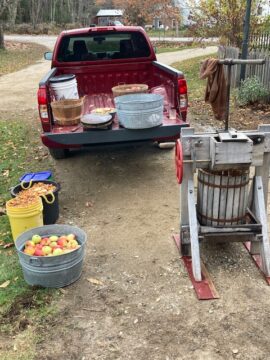
We carry on here in a similar fashion in the 21st century: At the end of October, we have bushels of unsold, blemished heritage apples cluttering up the cellar, and throughout the winter I will press cider, extracting “must” (juice) for the fermentation vessel and saving the “pomace” (wastage) for the pigs. This “hard” cider will later be hoarded until it builds up carbonation inside the bottles, and I’ll pour a cup or so of this liquor into the crockpot to moisten the stew meat. The following spring (if I can wait that long), I’ll begin cracking open bottles of effervescent cider to enjoy with my pan-fried pork chops.
Apples originated in Kazakhstan, not far from where the first swine were domesticated. I’ve already discussed what a nightmare it is to raise central Asian fruit trees in bloody cold, wet, infested New England. Dealing with the fungi, bacteria, weevils, moths, beetles and flies has been instrumental in ripping the organic-sustainable-Green-colored glasses from my eyes. Likewise with growing potatoes, the verdant tops of which are apt to be eaten down to stubs by beetles if one isn’t vigilant with the nerve poisons. Again, this species is an import, first domesticated by the ancient Peruvians and subsequently adopted by cultures all over the planet. The spud is somewhat synonymous with northern Maine now, in the same way the apple is synonymous with New England. This has all been made possible through the liberal application of pesticides. One doesn’t like to admit this, but it is true. I have contemplated a custom bumper sticker being made for my truck based on a commonly seen one (3):
NO PESTICIDES NO FOOD.
So much for organic ideals. The rest of the stew is not so exacting to grow: Onions, too, originated in the Middle East, as did carrots. Celeriac, with its delicious stem flesh, comes from the nearby Mediterranean basin. Garlic hales from Central Asia. The only other New World vegetable to join the potatoes in the stew is the tomato, from Central and South America, and not surprisingly from the same botanical family, Solanaceae. The stew is a true melting pot of comestibles. I won’t even go into the origins of the plants in the French herb mix we use to spice the stew.
The pork is the star of the stew, as it were, and raising swine over the years has increased my respect and love for these distant cousins of ours. We purchase piglets, Hampshire/Berkshire crosses, from a local farmer who breeds them, and we drive them home in a crate and thence to their pen. We raise them both outdoors and indoors, depending on the season we get them. We know the lives they lead–we’re responsible for keeping them well-fed, sheltered and comfortable–and I’m so attached to the knowledge that the flesh we eat at home is humanely raised that I don’t think I could ever eat store-bought hot dogs again (unless they’re chicken). We have enthusiastic friends and neighbors who buy shares of the animals, and we’re able to pass on nearly all the costs to them. Our profit consists of a year’s worth of pork in the freezer.
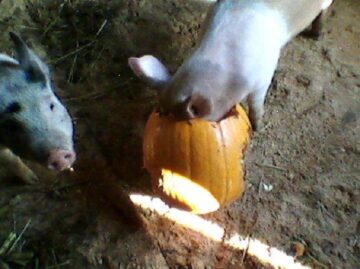
A pig is a cornucopia of delicious edible bits, with stew meat being pretty low down on the totem pole of cuts. Chops, shoulder, butt roasts, and ground meat come packaged fresh from a local custom butcher. Then there’s the cured and smoked meats. (Noah must have named his son Ham out of the dearest affection.) We’ve been known to have the butcher return to us fresh such parts as belly, hocks (knuckles), and jowls (cheeks), not frozen, so that we can salt-cure and apple wood-smoke the meat ourselves at home. This yields out-of-this-world bacon, as well as smoked ham hocks and jowls for addition into dishes such as bean soups and boiled greens.
Even the fatty portions of the animal are worth saving. Fat back–which as the name suggests comes from the back of the pig–can be salvaged in a large roll that may be cut into chunks and packed with coarse salt into crocks for preservation. It’s the traditional addition to Maine-style baked beans in a clay pot. The leaf lard, which is a long, convoluted roll of soft fat packed around the animal’s viscera, is the sine qua non of the home-raised pig: We cut this into small pieces and put it into a large pot with a little water then allow it to boil slowly on our cast iron cookstove for a few hours, until the “cracklings” turn brown and settle to the bottom of the pot. Then we pour the pure, melted fat into Ball Mason jars, which I am tempted just to sit and admire on the shelf for a while before I use it to fry potato pancakes (an abomination, I realize, which is why I don’t call them “latkes”). Most preciously, cold lard can be “cut” into whole wheat pastry flour to make the most scrumptious apple pie crusts one can imagine.
This is all lovely, and we are lucky to be in a position to do this in situ–we have access to land and a barn as tenants of the property. But none of it is sustainable, not in the literal sense of the word, meaning nothing nonrenewable being imported to the farm (4). Even though we are small–minuscule, even–we import and draw down finite resources, release carbon, and take up land, as any farming venture does. We are not “subsistence farmers”: Our work at home permits us to live at the dietary level of the average American, not as peasants. It beggars the imagination to consider what it must take in material resources and energy to raise food commercially for 8 billion people worldwide.
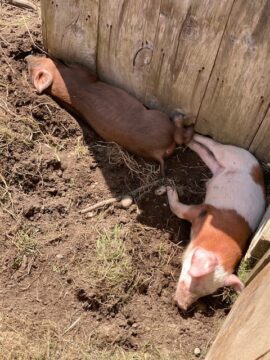
During a course in how to home-raise pigs that I attended through my university’s extension service, the expert instructor told anecdotes about naïve young farmers who wanted to grow “sustainably raised pastured pork” on their property. So, they fenced in a section of woods and field and turned the piglets loose. But the animals did not thrive; in fact, they looked sick; so, they called expert to see what they were doing wrong. He took one look at the pigs and said, “You’re not feeding them!” Pasturage, it turns out, like garden scraps and other food waste, cannot function alone as the main feed stock for domesticated swine but is instead supplementary. No matter how many apples, potatoes, pumpkins, squash or acorns grown or gathered on the farm that we feed our piglets, we still must have feed pellets trucked to the farm to meet the animals’ dietary requirements.
Neither are we self-sufficient. In addition to the suppliers and truckers who help ply our pigs with feed pellets, we rely on a custom butcher shop to process the meat for us. We could conceivably learn to kill and process the animals ourselves, but that is not going to happen: As it is, I can barely bring myself to kill and pluck a couple of turkeys every year.
Finally, and as promised, I want to draw attention to our big green secret ingredient. It’s our primary assistant when we till and cultivate our gardens, haul around crop materials, and transport tons of animal manure and compost. We could do very little of what we do now without it. It might not be sustainable, but it sure is green.
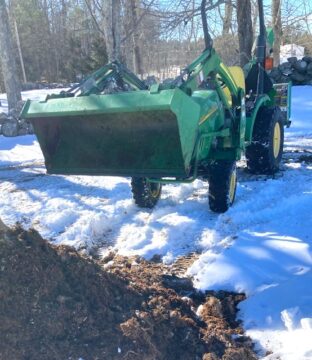
____________________________
Notes
(1) William Faulkner’s original quotation: “I discovered that my own little postage stamp of native soil was worth writing about and that I would never live long enough to exhaust it….” JSTOR
(2) The quotation is an altered version of Genesis 11:6-7, Tower Of Babel.
(3) No Farms No Food image.
(4) The Meaning of Sustainability.
Images
All photographs by the author.
